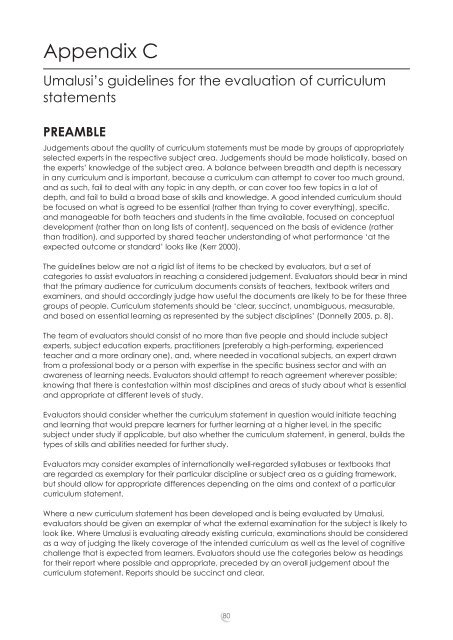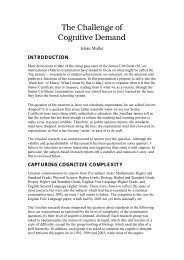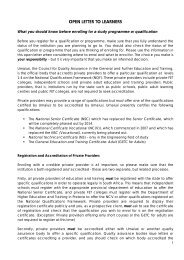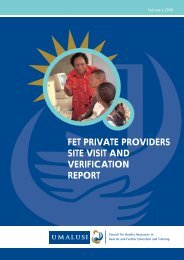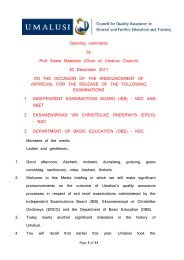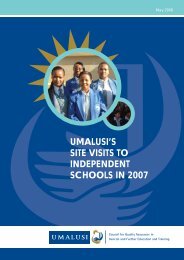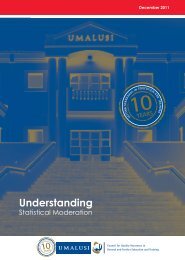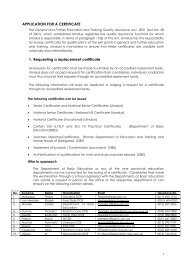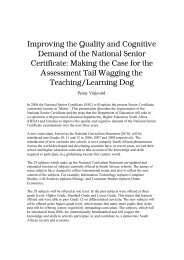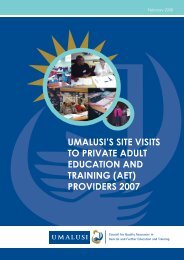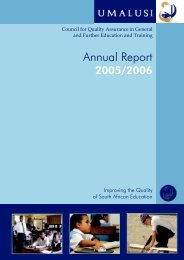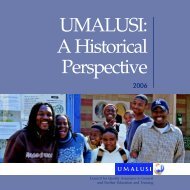Inspecting the Foundations - Umalusi
Inspecting the Foundations - Umalusi
Inspecting the Foundations - Umalusi
Create successful ePaper yourself
Turn your PDF publications into a flip-book with our unique Google optimized e-Paper software.
Appendix C<strong>Umalusi</strong>’s guidelines for <strong>the</strong> evaluation of curriculumstatementsPREAMBLEJudgements about <strong>the</strong> quality of curriculum statements must be made by groups of appropriatelyselected experts in <strong>the</strong> respective subject area. Judgements should be made holistically, based on<strong>the</strong> experts’ knowledge of <strong>the</strong> subject area. A balance between breadth and depth is necessaryin any curriculum and is important, because a curriculum can attempt to cover too much ground,and as such, fail to deal with any topic in any depth, or can cover too few topics in a lot ofdepth, and fail to build a broad base of skills and knowledge. A good intended curriculum shouldbe focused on what is agreed to be essential (ra<strong>the</strong>r than trying to cover everything), specifi c,and manageable for both teachers and students in <strong>the</strong> time available, focused on conceptualdevelopment (ra<strong>the</strong>r than on long lists of content), sequenced on <strong>the</strong> basis of evidence (ra<strong>the</strong>rthan tradition), and supported by shared teacher understanding of what performance ‘at <strong>the</strong>expected outcome or standard’ looks like (Kerr 2000).The guidelines below are not a rigid list of items to be checked by evaluators, but a set ofcategories to assist evaluators in reaching a considered judgement. Evaluators should bear in mindthat <strong>the</strong> primary audience for curriculum documents consists of teachers, textbook writers andexaminers, and should accordingly judge how useful <strong>the</strong> documents are likely to be for <strong>the</strong>se threegroups of people. Curriculum statements should be ‘clear, succinct, unambiguous, measurable,and based on essential learning as represented by <strong>the</strong> subject disciplines’ (Donnelly 2005, p. 8).The team of evaluators should consist of no more than fi ve people and should include subjectexperts, subject education experts, practitioners (preferably a high-performing, experiencedteacher and a more ordinary one), and, where needed in vocational subjects, an expert drawnfrom a professional body or a person with expertise in <strong>the</strong> specifi c business sector and with anawareness of learning needs. Evaluators should attempt to reach agreement wherever possible;knowing that <strong>the</strong>re is contestation within most disciplines and areas of study about what is essentialand appropriate at different levels of study.Evaluators should consider whe<strong>the</strong>r <strong>the</strong> curriculum statement in question would initiate teachingand learning that would prepare learners for fur<strong>the</strong>r learning at a higher level, in <strong>the</strong> specifi csubject under study if applicable, but also whe<strong>the</strong>r <strong>the</strong> curriculum statement, in general, builds <strong>the</strong>types of skills and abilities needed for fur<strong>the</strong>r study.Evaluators may consider examples of internationally well-regarded syllabuses or textbooks thatare regarded as exemplary for <strong>the</strong>ir particular discipline or subject area as a guiding framework,but should allow for appropriate differences depending on <strong>the</strong> aims and context of a particularcurriculum statement.Where a new curriculum statement has been developed and is being evaluated by <strong>Umalusi</strong>,evaluators should be given an exemplar of what <strong>the</strong> external examination for <strong>the</strong> subject is likely tolook like. Where <strong>Umalusi</strong> is evaluating already existing curricula, examinations should be consideredas a way of judging <strong>the</strong> likely coverage of <strong>the</strong> intended curriculum as well as <strong>the</strong> level of cognitivechallenge that is expected from learners. Evaluators should use <strong>the</strong> categories below as headingsfor <strong>the</strong>ir report where possible and appropriate, preceded by an overall judgement about <strong>the</strong>curriculum statement. Reports should be succinct and clear.80


